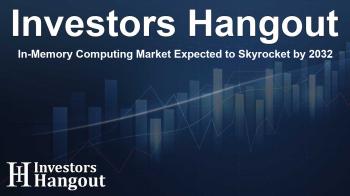In-Memory Computing Market Expected to Skyrocket by 2032

In-Memory Computing Market Size and Growth Prospects
In the ever-evolving landscape of technology, the In-Memory Computing (IMC) market is gaining significant momentum. According to recent analyses, the IMC market size was valued at USD 10.9 billion in 2023 and is forecasted to expand to an impressive USD 45.1 billion by 2032. This growth translates into a compound annual growth rate (CAGR) of approximately 17.08% during the period from 2024 to 2032. Leading the charge are businesses increasingly reliant on artificial intelligence (AI) and machine learning capabilities, as they seek to revolutionize their data processing speeds.
Accelerating Data Processing Capabilities
In today's data-driven world, organizations are in constant pursuit of faster data processing solutions. In-memory computing offers unmatched speed by allowing data to be processed in-memory, rather than relying on traditional disk-based storage that often introduces slowdowns. This capability is essential for sectors such as finance, healthcare, and manufacturing, where real-time analytics is paramount. Furthermore, with the advent of the Internet of Things (IoT) and edge computing, the reliance on IMC solutions is expected to skyrocket as businesses require instant decision-making from vast datasets.
Emerging Technologies Driving IMC
The expansion of memory technologies is also contributing to the growth of the IMC market. Innovations like high-bandwidth memory and processing-in-memory are set to enhance performance and efficiency. Companies are aggressively transitioning towards digital transformation, amplifying the demand for in-memory computing. As automation and AI continue to permeate various industries, the need for ultra-low latency solutions becomes increasingly critical, driving the market steadily forward.
Key Players in the In-Memory Computing Market
Several technology giants are also carving their niches within the IMC market. Notable players include:
- SAP SE with its SAP HANA platform
- IBM's Db2 with BLU Acceleration
- Microsoft offering Azure SQL Database In-Memory
- Oracle's TimesTen In-Memory Database
- Intel's Optane DC Persistent Memory
- VMware with its vSphere technology
- Amazon Web Services' ElastiCache solution
- Redis Labs focusing on Redis Enterprise
This robust competitive landscape indicates varied strategies, from software to hardware advancements, sparking innovations that fuel market growth.
Segments and Applications of In-Memory Computing
The In-Memory Computing market can be segmented based on components, applications, and verticals. The hardware segment currently dominates the market, accounting for a significant revenue share due to the uptick in high-performance memory module demand. Meanwhile, the software segment is expected to experience the fastest growth as businesses increasingly seek solutions that integrate seamlessly with their existing systems.
Application Trends: Fraud Detection and Real-Time Analytics
In terms of applications, fraud detection leads the way with a substantial share of over 41%, as businesses in banking and e-commerce prioritize swift response capabilities to combat rising cyber threats. Real-time analytics is on course to experience the highest growth rate, with industries embracing data-driven insights to derive actionable intelligence rapidly.
Regional Insights: Leadership and Growth
North America remains the dominant player in the IMC market, underpinned by a strong infrastructure and technological innovations emerging from the region. As AI and big data analytics are increasingly adopted, the U.S. particularly fuels sector demand for in-memory solutions.
Simultaneously, the Asia-Pacific region is projected to witness the fastest growth rate during the forecast period, driven by major investments in digital infrastructures and rapid advancements in technology across countries like China and India.
Conclusion: The Future of In-Memory Computing
As we look ahead, the thirst for faster, more efficient data processing technologies will only intensify. Innovations in platforms such as SAP HANA and Intel Optane DC memory are setting the standards for improved capabilities. The surge in demand for in-memory computing solutions promises a thriving future for businesses willing to embrace these transformations.
Frequently Asked Questions
What is the current market size of In-Memory Computing?
The In-Memory Computing market was valued at USD 10.9 billion in 2023 and is projected to grow to USD 45.1 billion by 2032.
What are the major drivers of growth in this market?
Key drivers include the increasing demand for real-time analytics and AI-driven applications, along with rapid advancements in memory technologies.
Which sectors are leading the demand for In-Memory Computing?
The finance, healthcare, and manufacturing sectors are at the forefront, requiring rapid data processing and analytics.
Who are the key players in the In-Memory Computing industry?
Notable companies include SAP, IBM, Microsoft, Oracle, Intel, AWS, and Redis Labs.
What is the expected CAGR for this market?
The In-Memory Computing market is expected to grow at a CAGR of approximately 17.08% from 2024 to 2032.
About The Author
Contact Olivia Taylor privately here. Or send an email with ATTN: Olivia Taylor as the subject to contact@investorshangout.com.
About Investors Hangout
Investors Hangout is a leading online stock forum for financial discussion and learning, offering a wide range of free tools and resources. It draws in traders of all levels, who exchange market knowledge, investigate trading tactics, and keep an eye on industry developments in real time. Featuring financial articles, stock message boards, quotes, charts, company profiles, and live news updates. Through cooperative learning and a wealth of informational resources, it helps users from novices creating their first portfolios to experts honing their techniques. Join Investors Hangout today: https://investorshangout.com/
The content of this article is based on factual, publicly available information and does not represent legal, financial, or investment advice. Investors Hangout does not offer financial advice, and the author is not a licensed financial advisor. Consult a qualified advisor before making any financial or investment decisions based on this article. This article should not be considered advice to purchase, sell, or hold any securities or other investments. If any of the material provided here is inaccurate, please contact us for corrections.

